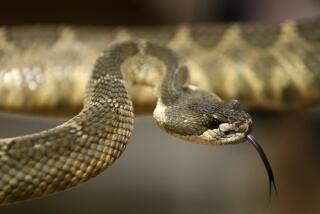It’s rattlesnake season: 12 things you need to know
- Share via
It’s rattlesnake season. Spring’s gray weather draws snakes out at times you’re more likely to encounter them. Contrary to what you may think, local rattlers don’t like super-hot days. “Warm and overcast are perfect conditions for snakes to come out,” said Ian Recchio, curator of reptiles at the L.A. Zoo. “They don’t come out on 100 degree days.”
Starting each spring, Southern Pacific rattlesnakes (Crotalus oreganus helleri), the most common species in the L.A. area, come out of hibernation to mate. It’s the time of year you’re most likely to come across them in the wild. Right now, you can expect to find them stretched across the trails of Griffith Park or hanging out in your backyard.
Here are some things you need to know if you encounter a rattlesnake anywhere besides the zoo.
1. When does rattlesnake season end?
You won’t find it marked on any calendar, and there’s no specific end date. The season starts in spring and lasts until L.A.’s really big heat, when the snakes become nocturnal and you’re much less likely to encounter them in the wilderness. When the heat hits, they largely disappear from view: “In summer, they’re moving when people aren’t, in the middle of the night,” Recchio said.
2. What do rattlesnakes found around L.A. look like?
They tend to blend into the landscape. Southern Pacific snakes have thick bodies and short, stubby tails with a clear, hollow rattle at the end. They have triangular heads, can be up to 4 feet long, and come in a variety of colors: pale or dark brown, gray, and everything in between, with a diamond pattern of lighter dots on their bodies.
3. What should I do if I see a rattler when I’m out hiking?
Nothing, except maybe take a picture — at a distance. Local rattlers are pretty docile and don’t like conflict, Recchio said. Don’t even think about picking them up or poking them with a stick.
If you’re on a trail, give the snake a wide berth and walk by. If you can’t pass comfortably at a distance, retrace your steps. Hikers also should take precautionary measures to wear long pants and boots that protect their ankles. Also, never hike alone in case you get bitten and need a second person to get help.
4. Should you yell or throw rocks to get rattlers to move?
Stop embarrassing yourself. Snakes don’t hear well, so they’re impervious to your shouts. And beaning them with a rock would irritate or hurt them. Leave them alone and respect their space.
5. What does it mean if I hear a rattling noise?
It means you need to be very careful. Rattlers are one of the few species that sometimes give you a clear warning they may be ready to strike. Scan the area and try to locate the snake, then take heed and back away. But know this: Not all rattlesnakes rattle before they strike.
6. What should I do if I get bitten?
Let’s start with this: “If you get bit, it’s because you were too close,” said Dr. Cyrus Rangan, director of toxicology at L.A. County Public Health and assistant medical director at the California Poison Control Center, calpoison.org, (800) 222‑1222.
You need to call 911 or go to an emergency room immediately. (It’s a good idea to know where the nearest emergency room is before you go hiking.) Also, if possible, wash the wound with soap and water, and elevate the afflicted arm or leg above the level of the heart. At the hospital, you may be monitored and, if necessary, treated with antivenom, depending on the bite (some may suffer “dry” bites, in which no venom is injected into the person’s leg or arm).
It’s hard to say how many people have been bitten by rattlesnakes because reporting is voluntary. Last year the California Poison Control System received 282 calls about snakebites statewide; this year, 105 so far.
7. Is it OK to run or hike out to get help if you’ve been bitten?
“Do whatever it takes to get help as soon as possible,” Rangan said.
The idea that moving around pumps venom through your body more quickly isn’t accurate. Rangan explained that venom circulates not by blood but through your lymphatic system, which moves fluids more slowly through the body.
What you absolutely shouldn’t do is anything you saw in those old western movies, such as putting a tourniquet on the affected limb, cutting an “X” over the bite and sucking out the venom, or packing it with ice.
8. Can you die from a rattlesnake bite?
Yes, but it’s very rare, Rangan said. Some people may be allergic to the venom or get bit directly into an artery or vein, which would cause a lot of blood loss.
9. I just killed a rattler in my backyard because I have small children around. That’s OK, right?
No. If you want to get rid of a rattlesnake in your backyard, call L.A. County’s Department of Animal Care and Control, animalcare.lacounty.gov (phone numbers on website are listed by area). Also, you should never pick up a dead or dying snake because the it could still transmit venom if you nick yourself on the fang.
10. What if my dog gets a rattlesnake bite?
Dogs have a little higher resistance to snakebites than humans do, Recchio said. “Dogs can die, though in general, they survive … even without treatment.”
Still the bite may be painful, and pet owners should take the dog to a veterinarian to get checked out. One preventive measure: Keep your dog on a leash while walking or hiking in rattlesnake areas.
11. Are baby rattlesnake bites more toxic to humans?
Not really. Though young rattlers are said to be unable to control their venom (though that’s disputed by some), “bigger snakes have bigger venom sacs, and adults can deliver far greater volumes of venom than babies,” herpetologist Greg Pauly of L.A.’s Natural History Museum explained in the publication Bay Nature.
12. Where can I see rattlesnakes?
Several locations in Los Angeles have displays where snakes can safely be seen, such as the L.A. Zoo, Deane Dana Friendship Natural Area in San Pedro, and the Eaton Canyon Nature Center in Pasadena.
ALSO
More to Read
Sign up for The Wild
We’ll help you find the best places to hike, bike and run, as well as the perfect silent spots for meditation and yoga.
You may occasionally receive promotional content from the Los Angeles Times.







